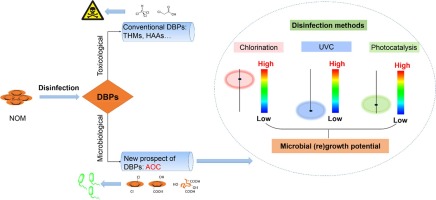当前位置:
X-MOL 学术
›
Environ. Int.
›
论文详情
Our official English website, www.x-mol.net, welcomes your
feedback! (Note: you will need to create a separate account there.)
Formation of assimilable organic carbon (AOC) during drinking water disinfection: A microbiological prospect of disinfection byproducts.
Environment International ( IF 10.3 ) Pub Date : 2019-12-12 , DOI: 10.1016/j.envint.2019.105389 Guocheng Huang 1 , Tsz-Wai Ng 2 , Huan Chen 3 , Alex T Chow 3 , Shengwei Liu 4 , Po Keung Wong 5
Environment International ( IF 10.3 ) Pub Date : 2019-12-12 , DOI: 10.1016/j.envint.2019.105389 Guocheng Huang 1 , Tsz-Wai Ng 2 , Huan Chen 3 , Alex T Chow 3 , Shengwei Liu 4 , Po Keung Wong 5
Affiliation

|
Disinfection processes might alter the chemical structure of biological recalcitrant natural organic matter (NOM) in source water to form assimilable organic carbon (AOC), which can be readily utilized by microbes for growth. However, AOC has not been classified as disinfection byproducts (DBPs) before and little is known about the chemical and structural nature of AOC. This study, for the first time, considers the disinfection-induced AOC as DBPs from a microbiological perspective. The AOC formation by three types of disinfection processes, i.e., chlorination, UVC irradiation (254 nm) and photocatalysis represented by TiO2-UVA in drinking water containing two reference NOM materials of Suwannee River and Nordic Reservoir (SRNOM and NRNOM, respectively) were comparatively benchmarked using Pseudomonas aeruginosa as inoculum. Results showed that chlorination caused a substantial increase in AOC content, whereas TiO2-UVA led to a moderate increase in AOC content and UVC rendered the AOC content unchanged, independent of the types of NOM. Molecular weight indicated by spectral slope ratio and fluorescence fingerprint were found to not provide critical information about the AOC formation potential. FTIR and FT-ICR-MS results indicated that the AOC formation by chlorination was attributed to the oxidation and chlorine substitution on aromatic molecules to form molecules with carboxylic- and alcohol- functionalities, as well as chlorinated aromatics. These molecules could be metabolized and assimilated by Pseudomonas species by a catechol pathway. The results obtained in this study can provide valuable insight regarding the selection of proper technologies for disinfection to prevent microbial growth/regrowth in the distributing system and is intended to encourage more thinking and research on AOC as a new prospect of DBPs during disinfection of drinking water.
中文翻译:

饮用水消毒过程中同化有机碳(AOC)的形成:消毒副产物的微生物学前景。
消毒过程可能会改变原水中生物难降解的天然有机物(NOM)的化学结构,从而形成可吸收的有机碳(AOC),微生物可轻易利用其进行生长。但是,以前尚未将AOC归类为消毒副产物(DBP),并且对AOC的化学和结构性质了解甚少。这项研究首次从微生物学的角度将消毒诱导的AOC视为DBP。比较比较了苏旺尼河和北欧水库中两种参考NOM物质(分别为SRNOM和NRNOM)在饮用水中的三种消毒过程的AOC形成,即氯化,UVC辐照(254 nm)和以TiO2-UVA表示的光催化。使用铜绿假单胞菌作为接种物进行基准测试。结果表明,氯化作用导致AOC含量大幅增加,而TiO2-UVA导致AOC含量适度增加,而UVC则使AOC含量保持不变,而与NOM的类型无关。发现由光谱斜率比和荧光指纹指示的分子量不能提供有关AOC形成潜力的关键信息。FTIR和FT-ICR-MS结果表明,氯化生成的AOC归因于芳族分子上的氧化和氯取代,从而形成具有羧酸和醇官能团的分子以及氯化芳族化合物。这些分子可以通过儿茶酚途径被假单胞菌种类代谢和吸收。
更新日期:2019-12-13
中文翻译:

饮用水消毒过程中同化有机碳(AOC)的形成:消毒副产物的微生物学前景。
消毒过程可能会改变原水中生物难降解的天然有机物(NOM)的化学结构,从而形成可吸收的有机碳(AOC),微生物可轻易利用其进行生长。但是,以前尚未将AOC归类为消毒副产物(DBP),并且对AOC的化学和结构性质了解甚少。这项研究首次从微生物学的角度将消毒诱导的AOC视为DBP。比较比较了苏旺尼河和北欧水库中两种参考NOM物质(分别为SRNOM和NRNOM)在饮用水中的三种消毒过程的AOC形成,即氯化,UVC辐照(254 nm)和以TiO2-UVA表示的光催化。使用铜绿假单胞菌作为接种物进行基准测试。结果表明,氯化作用导致AOC含量大幅增加,而TiO2-UVA导致AOC含量适度增加,而UVC则使AOC含量保持不变,而与NOM的类型无关。发现由光谱斜率比和荧光指纹指示的分子量不能提供有关AOC形成潜力的关键信息。FTIR和FT-ICR-MS结果表明,氯化生成的AOC归因于芳族分子上的氧化和氯取代,从而形成具有羧酸和醇官能团的分子以及氯化芳族化合物。这些分子可以通过儿茶酚途径被假单胞菌种类代谢和吸收。











































 京公网安备 11010802027423号
京公网安备 11010802027423号